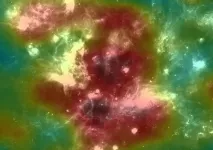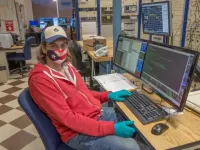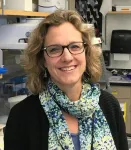HAWC Gamma Ray Observatory discovers origin of highest-energy cosmic rays in the galaxy
Photon origins tracked to Cygnus OB2 star-forming region
2021-03-11
(Press-News.org) LOS ALAMOS, N.M., March 11, 2021--A long-time question in astrophysics appears to finally be answered, thanks to a collection of large, high-tech water tanks on a mountainside in Mexico. The High-Altitude Water Cherenkov (HAWC) data shows that the highest-energy cosmic rays come not from supernovae, but from star clusters.
"The origin of the highest-energy cosmic rays in the galaxy has been an open question in astrophysics for more than 60 years," said Patrick Harding, a Los Alamos National Laboratory astrophysicist doing research using HAWC. "Very few regions of the galaxy have both the power to produce high-energy particles and the necessary environments to boost those particles to the petaelectronVolt (PeV) energies that are seen in the highest-energy cosmic rays. And most of the expected regions to produce the particles have been ruled out in recent years by high-energy observatories."
"In this paper, we discover high-energy gamma rays coming from Cygnus OB2, a birthplace of massive stars located inside the 'Cygnus Cocoon' superbubble, meaning it is likely the source of these highest-energy galactic cosmic rays," Harding said.
The cosmic rays have been observed striking Earth's atmosphere at PeV energies by the detection tanks at the HAWC observatory near Puebla, Mexico. Instead of supernovae, this work shows that star clusters such as the Cygnus Cocoon serve as "PeVatrons" -- PeV accelerators capable of creating high-energy particles that travel across the galaxy.
The algorithms used to analyze the highest-energy HAWC photons, which were used in a paper published today in Nature Astronomy, were developed by Los Alamos postdoctoral researcher Kelly Malone. Additionally, the paper which first identified the Cocoon as a significant emitter of high-energy gamma-rays using the HAWC high-energy catalog, was also led by Malone, who is the leader of the Galactic Science Working Group within HAWC.
"HAWC is the first observatory to detect gamma rays from across the sky with energies above 100 TeV. This high-energy reach allows us to answer fundamental questions about our galaxy," said Malone.
The consequences of this result are relevant for several areas of Los Alamos astrophysics study: The transport of cosmic rays and their interactions with the surrounding medium are of interest at the Laboratory, and in particular, Los Alamos studies which types of astronomical sources can efficiently accelerate cosmic rays to high energy, and which acceleration mechanism enables it. Identifying a source of these high-energy cosmic rays will lead to greater theoretical understanding of these mechanisms.
INFORMATION:
The research was primarily conducted by Petra Huentemeyer, professor of physics at Michigan Technological University, along with MTU graduate Binita Hona (now a postdoc at University of Utah), doctoral student Dezhi Huang, former MTU postdoc Henrike Fleischhack (now at Catholic University/NASA GSFC/CRESST II), Sabrina Casanova at the Institute of Nuclear Physics Polish Academy of Sciences in Krakow, Ke Fang at the University of Wisconsin and Roger Blandford at Stanford University, along with numerous other collaborators of the HAWC Observatory.
The paper: HAWC observations of the acceleration of very-high-energy cosmic rays in the Cygnus Cocoon, Nature Astronomy, 11 March 2021, DOI: 10.1038/s41550-021-01318-y
The funding: HAWC research is funded by the National Science Foundation (NSF), the U.S. Department of Energy Office of Science, the LDRD program of Los Alamos National Laboratory, CONACyT, México, and the Polish Science Centre (among others).
About Los Alamos National Laboratory
Los Alamos National Laboratory, a multidisciplinary research institution engaged in strategic science on behalf of national security, is managed by Triad, a public service oriented, national security science organization equally owned by its three founding members: Battelle Memorial Institute (Battelle), the Texas A&M University System (TAMUS), and the Regents of the University of California (UC) for the Department of Energy's National Nuclear Security Administration.
Los Alamos enhances national security by ensuring the safety and reliability of the U.S. nuclear stockpile, developing technologies to reduce threats from weapons of mass destruction, and solving problems related to energy, environment, infrastructure, health, and global security concerns.
LAUR: LA-UR-21-22418
[Attachments] See images for this press release:

ELSE PRESS RELEASES FROM THIS DATE:
2021-03-11
Black women have 80% higher risk of preterm birth between 32 and 33 weeks of pregnancy if a Black person who lives in their neighborhood is killed by police during the pregnancy, according to a study by researchers at UC San Francisco and UC Berkeley.
The study by scientists at the UCSF California Preterm Birth Initiative (PTBI-CA) and UC Berkeley School of Public Health, studied the records of 3.8 million pregnant women to assess whether fatal police violence occurring in their neighborhood during pregnancy was associated with extremely early, early, moderate or late preterm delivery.
"Our findings suggest that deaths due to police violence, which already differentially affect Black and Brown communities, adversely affect the health of mothers and babies ...
2021-03-11
BOSTON - As COVID-19 infection rates continue to fall, Massachusetts officials are signaling it's almost time to end remote learning and send all school-aged children back to the classroom. While emerging data suggest young children and schools have not been primary drivers of the COVID-19 pandemic, evidence to guide best practices to prevent the spread of the virus in the school setting has been limited and, as a result, national and international recommendations are inconsistent.
A study led by Beth Israel Deaconess Medical Center (BIDMC) physician-researchers provides new, much-needed data about the optimal physical ...
2021-03-11
Climate change is affecting the water balance of our planet: depending on the region and the time of year, this can influence the amount of water in rivers potentially resulting in more flooding or drought. River flow is an important indicator of water resources available to humans and the environment. The amount of available water also depends on further factors, such as direct interventions in the water cycle or land use change: if, for example, water is diverted for irrigation or regulated via reservoirs, or forests are cleared and monocultures grown in their place, this can have an impact on river flow.
However, how river flow ...
2021-03-11
Using the same principles that make polarized sunglasses possible, a team of researchers at the Arecibo Observatory in Puerto Rico have developed a technique that will help better defend against asteroids on a collision course with Earth.
A new study recently published in The Planetary Science Journal found a better way to interpret radar signals bounced off asteroids' surfaces. The data can better tell us if an asteroid is porous, fluffy or rocky, which matters because there are hundreds of near-Earth asteroids that could potentially hit the planet.
"Learning more about the physical properties of asteroids is crucial in Planetary Defense," says Dylan Hickson the lead author and a research scientist at the Arecibo Observatory in Puerto Rico. "A porous, fluffy asteroid does ...
2021-03-11
The planet GJ 1132 b appears to have begun life as a gaseous world with a thick blanket of atmosphere. Starting out at several times the radius of Earth, this so-called "sub-Neptune" quickly lost its primordial hydrogen and helium atmosphere, which was stripped away by the intense radiation from its hot, young star. In a short period of time, it was reduced to a bare core about the size of Earth.
To the surprise of astronomers, new observations from Hubble [1] have uncovered a secondary atmosphere that has replaced the planet's first atmosphere. It is rich in hydrogen, hydrogen cyanide, methane and ammonia, and also has a hydrocarbon haze. Astronomers theorise that hydrogen from the original atmosphere was absorbed into the planet's molten magma mantle and is now being slowly released ...
2021-03-11
Breast cancer is harmful enough on its own, but when cancer cells start to metastasize -- or spread into the body from their original location -- the disease becomes even more fatal and difficult to treat.
Thanks to new research published in Oncogene from the lab of University of Colorado Cancer Center associate director of basic research Heide Ford, PhD, in collaboration with Michael Lewis, PhD, from Baylor College of Medicine, doctors may soon have a better understanding of one mechanism by which metastasis happens, and of potential ways to slow it down.
"Metastasis is a huge problem nobody's tackled very well," says Ford, who ...
2021-03-11
The universe is filled with magnetic fields. Understanding how magnetic fields are generated and amplified in plasmas is essential to studying how large structures in the universe were formed and how energy is divided throughout the cosmos.
An international collaboration, co-led by researchers at the University of Rochester, the University of Oxford, and the University of Chicago, conducted experiments that captured for the first time in a laboratory setting the time history of the growth of magnetic fields by the turbulent dynamo, a physical mechanism thought to be responsible for generating ...
2021-03-11
Optical-resolution photoacoustic microscopy (OR-PAM), a new hybrid imaging technique, allows us to listen to the sound of light and see the color of biological tissue itself. It can be used for live, multicontrast functional imaging, but the limited wavelength choice of most commercial lasers and the limitations of the existing scanning methods have meant that OR-PAM can obtain only one or two different types of contrast in a single scan. These limitations have made multicontrast functional imaging time-consuming, and it's been difficult to capture the ...
2021-03-11
Ann Arbor, March 11, 2020 - Black and Hispanic people experience a higher risk for COVID-19 and severe illness, influenced by factors such as discrimination, housing, and healthcare access and utilization. Now, a END ...
2021-03-11
CHAMPAIGN, Ill. -- The chronic stress of living in neighborhoods with high rates of violence and poverty alters gene activity in immune cells, according to a new study of low-income single Black mothers on the South Side of Chicago.
The changes in stress-related gene expression reflect the body's "hunker down" response to long-term threat, a physiological strategy for lying low and considering new actions rather than launching an immediate "fight-or-flight" response. This has implications for health outcomes in communities of color and other marginalized populations, said researchers at the University of Illinois Urbana-Champaign and collaborators at the University of Kentucky and UCLA. The researchers published the study in the journal Psychoneuroendocrinology.
"The ...
LAST 30 PRESS RELEASES:
[Press-News.org] HAWC Gamma Ray Observatory discovers origin of highest-energy cosmic rays in the galaxy
Photon origins tracked to Cygnus OB2 star-forming region




